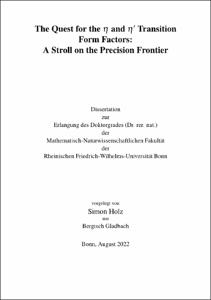The Quest for the η and η' Transition Form FactorsA Stroll on the Precision Frontier

The Quest for the η and η' Transition Form Factors
A Stroll on the Precision Frontier

| dc.contributor.advisor | Kubis, Bastian | |
| dc.contributor.author | Holz, Simon | |
| dc.date.accessioned | 2022-10-04T12:17:11Z | |
| dc.date.available | 2022-10-04T12:17:11Z | |
| dc.date.issued | 04.10.2022 | |
| dc.identifier.uri | https://hdl.handle.net/20.500.11811/10336 | |
| dc.description.abstract | An important precision test of the Standard Model of Particle Physics is posed by the prediction of the anomalous magentic moment of the muon. Currently, a deviation of about 4.2σ persists between the experimental average of this quantity and its prediction, the error of which is dominated by hadronic uncertainties. This thesis is aimed at constructing a dispersive data-driven representation of the η and η' transition form factors and subsequently obtaining their pole contributions in the hadronic light-by-light scattering part in the prediction of the muon g-2.
A representation of the singly-virtual η' transition form factor is constructed in the time-like regime. This representation is obtained by a multi-channel formalism dispersively combining data for η'→π+π−γ and the pion vector form factor. Furthermore, it consistently takes the isospin-breaking ρ-ω-mixing effect in both the isovector as well as the isoscalar channel into account. A step into the doubly-virtual regime of the η transition form factor is taken by analyzing data for the reaction e+e−→π+π-η. It is demonstrated that the a2 tensor meson provides a natural breaking mechanism of the commonly applied factorization ansatz in the doubly-virtual form factor. The model of factorization breaking through the left-hand-cut contribution of the a2 by crossed-channel effects is further employed in the construction of the η and η' transition form factors starting from the decay η'→2(π+π-). In this decay the a2 left-hand-cut contribution leads to an inhomogeneous Omnès problem, whose solution is numerically challenging. A solution strategy through path deformation in the corresponding dispersion integral is followed. Subsequently, the further application of dispersion relations leads to representations of η(')→γ*γ*. The pole contributions of pseudoscalar mesons to the hadronic light-by-light scattering part in the muon g-2 are solely determined from the corresponding transition form factors. The general strategy in case of the η and η' mesons is outlined in terms of a simplified form factor model excluding factorization-breaking effects. It is demonstrated that the supplementation of the form factor’s dispersive part by contributions motivated by the fulfillment of the corresponding asymptotic limits leads to a description with quantifiable and controlled sources of uncertainties. The corresponding pole contributions and their uncertainty estimates were extracted by carrying out the g-2 loop integrals. The strategy outlined can also be applied for the full-fledged model including factorization-breaking effects. | en |
| dc.language.iso | eng | |
| dc.rights | In Copyright | |
| dc.rights.uri | http://rightsstatements.org/vocab/InC/1.0/ | |
| dc.subject | anomalous magnetic moment | |
| dc.subject | hadronic light-by-light scattering | |
| dc.subject | transition form factor | |
| dc.subject | pseudoscalar meson | |
| dc.subject | dispersion relations | |
| dc.subject | data-driven approach | |
| dc.subject | muon | |
| dc.subject | isospin breaking | |
| dc.subject | factorization breaking | |
| dc.subject.ddc | 530 Physik | |
| dc.title | The Quest for the η and η' Transition Form Factors | |
| dc.title.alternative | A Stroll on the Precision Frontier | |
| dc.type | Dissertation oder Habilitation | |
| dc.publisher.name | Universitäts- und Landesbibliothek Bonn | |
| dc.publisher.location | Bonn | |
| dc.rights.accessRights | openAccess | |
| dc.identifier.urn | https://nbn-resolving.org/urn:nbn:de:hbz:5-67976 | |
| dc.relation.arxiv | 2006.04822 | |
| dc.relation.arxiv | 2203.15810 | |
| dc.relation.doi | https://doi.org/10.1140/epjc/s10052-021-09661-0 | |
| dc.relation.doi | https://doi.org/10.1140/epjc/s10052-022-10247-7 | |
| ulbbn.pubtype | Erstveröffentlichung | |
| ulbbnediss.affiliation.name | Rheinische Friedrich-Wilhelms-Universität Bonn | |
| ulbbnediss.affiliation.location | Bonn | |
| ulbbnediss.thesis.level | Dissertation | |
| ulbbnediss.dissID | 6797 | |
| ulbbnediss.date.accepted | 12.09.2022 | |
| ulbbnediss.institute | Mathematisch-Naturwissenschaftliche Fakultät : Fachgruppe Physik/Astronomie / Helmholtz-Institut für Strahlen- und Kernphysik (HISKP) | |
| ulbbnediss.fakultaet | Mathematisch-Naturwissenschaftliche Fakultät | |
| dc.contributor.coReferee | Hanhart, Christoph | |
| ulbbnediss.contributor.orcid | https://orcid.org/0000-0001-8193-0928 | |
| ulbbnediss.contributor.gnd | 1280956291 |
Dateien zu dieser Ressource
Das Dokument erscheint in:
-
E-Dissertationen (4378)




